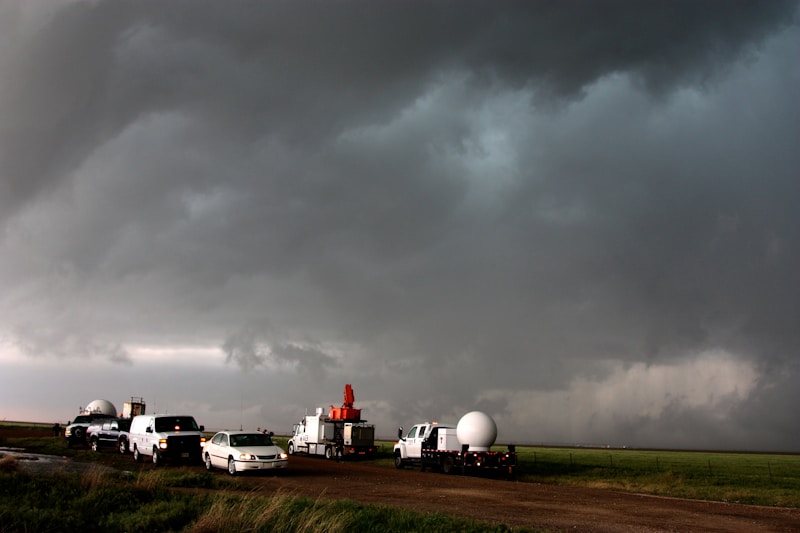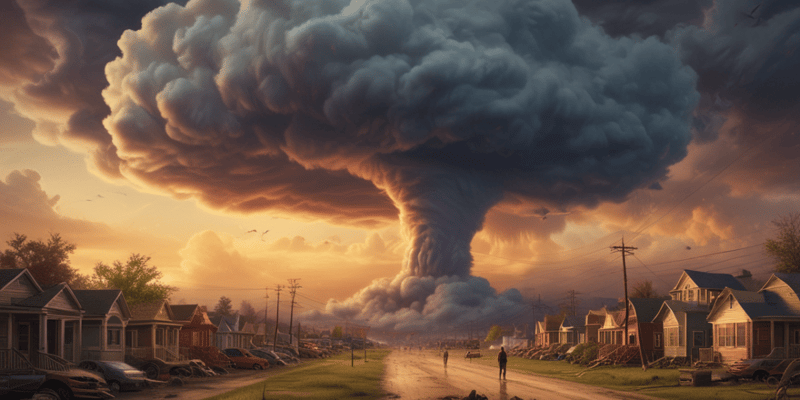9 Questions
What is the average number of tornadoes reported in Canada per year?
Which of the following is NOT a type of tornado?
What is the deadliest single tornado in US history?
What is the most common misconception about tornado safety?
What is the name of the scale used to rate the strength of tornadoes?
What is the characteristic of a multiple-vortex tornado?
What is the most common type of tornado in the United States?
What is the life cycle of a supercell tornado?
What is the role of storm spotters in tornado detection?
Summary
Tornadoes: Characteristics, Types, and Rating Scales
-
Tornadoes are violently rotating columns of air that are in contact with both the surface of the Earth and a cumulonimbus cloud or, in rare cases, the base of a cumulus cloud.
-
They come in many shapes and sizes, with wind speeds typically less than 180 km/h and a diameter of about 80 meters.
-
The most extreme tornadoes can attain wind speeds of more than 480 km/h, are more than 3 km in diameter, and stay on the ground for more than 100 km.
-
Tornadoes occur most frequently in North America, particularly in central and southeastern regions of the United States, colloquially known as Tornado Alley.
-
Various types of tornadoes include multiple vortex tornadoes, landspouts, and waterspouts.
-
Waterspouts are generally classified as non-supercellular tornadoes that develop over bodies of water; they are less common at high latitudes.
-
Tornadoes can be detected before or as they occur through the use of pulse-Doppler radar and the efforts of storm spotters.
-
There are several scales for rating the strength of tornadoes, including the Fujita scale and the updated Enhanced Fujita Scale.
-
Tornadoes can have a wide range of colors depending on the environment in which they form, and they can be obscured by rain or dust.
-
Tornadoes can have a clear, calm center with extremely low pressure, akin to the eye of tropical cyclones.
-
Tornadoes normally rotate cyclonically, when viewed from above, but approximately 1 percent of tornadoes rotate in an anticyclonic direction in the northern hemisphere.
-
Tornadoes emit widely on the acoustics spectrum, and the sounds are caused by multiple mechanisms such as the winds of the tornado vortex and constituent turbulent eddies.Understanding Tornadoes: Formation, Life Cycle, and Types
-
Tornadoes emit on the electromagnetic spectrum, with sferics and E-field effects detected; there are correlations between tornadoes and patterns of lightning.
-
Tornadoes often develop from a class of thunderstorms known as supercells; most intense tornadoes develop from supercells.
-
Supercell tornadoes follow a recognizable life cycle, which begins when increasing rainfall drags with it an area of quickly descending air known as the rear flank downdraft.
-
The convergence of warm air in the updraft and cool air causes a rotating wall cloud to form; as the updraft intensifies, it creates an area of low pressure at the surface, pulling the focused mesocyclone down.
-
A multiple-vortex tornado is a type of tornado in which two or more columns of spinning air rotate about their own axes and at the same time revolve around a common center.
-
A landspout, or dust-tube tornado, is a tornado not associated with a mesocyclone; they are usually weaker than classic tornadoes but can produce strong winds.
-
The Fujita scale and the Enhanced Fujita Scale rate tornadoes by damage caused; an EF0 tornado will probably damage trees but not substantial structures, whereas an EF5 tornado can rip buildings off their foundations.
-
Tornadoes vary in intensity regardless of shape, size, and location, though strong tornadoes are typically larger than weak tornadoes.
-
In the United States, 80% of tornadoes are EF0 and EF1 (T0 through T3) tornadoes; less than 1% are violent tornadoes (EF4, T8 or stronger).
-
The United States has the most tornadoes of any country, nearly four times more than estimated in all of Europe, excluding waterspouts.
-
North America is a large continent that extends from the tropics north into arctic areas, and has no major east–west mountain range to block air flow between these two areas, which allows for frequent collisions of warm and cold air.
-
Tornadoes also exhibit changes in atmospheric variables such as temperature, moisture, and atmospheric pressure; temperature tends to decrease and moisture content to increase in the immediate vicinity of a tornado.
-
Although this is a widely accepted theory for how most tornadoes form, live, and die, it does not explain the formation of smaller tornadoes, such as landspouts, long-lived tornadoes, or tornadoes with multiple vortices.Summary Title: Tornadoes: Occurrence, Detection, Safety, and Myths
-
Tornadoes are most common in Tornado Alley in the central United States and Canada, but also occur in other parts of the world, including South Africa, Europe, Australia, and Asia.
-
The United States experiences an average of 1,200 tornadoes per year, while Canada averages 62 reported per year, with the Netherlands and the UK having the highest average number of recorded tornadoes per area of any country.
-
Tornadoes are most common in spring and fall, but can occur at any time of year when favorable conditions are present.
-
Climate and environmental trends can influence tornado activity, with increased sea surface temperatures and El Niño/La Niña phases affecting severe weather and tornado activity.
-
Rigorous attempts to warn of tornadoes began in the mid-20th century with the advent of weather radar, and today most developed countries have a network of weather radars to detect hook signatures associated with tornadoes.
-
Storm spotters are trained to recognize key features of storms indicating severe hail, damaging winds, and tornadoes, and provide ground truth information to complement radar data.
-
The Tri-State Tornado of 1925 holds records for longest path length, longest duration, and fastest forward speed for a significant tornado, as well as being the deadliest single tornado in US history.
-
Safety measures include having a pre-determined plan should a tornado warning be issued, seeking shelter in a basement or interior first-floor room of a sturdy building, or getting low in a ditch if no shelter is available.
-
Myths and misconceptions include the belief that a green sky is specifically associated with tornadoes, and that opening windows will lessen the damage caused by the tornado.Misconceptions and Ongoing Research on Tornadoes
-
A violent tornado can destroy a house whether its windows are open or closed.
-
Highway overpasses are not safe places during a tornado, and the subjects of the video who remained safe under an overpass during a tornado in 1991 did so because the tornado was weak, did not strike the overpass directly, and the overpass was of a unique design.
-
The safest place during a tornado is the side or corner of an underground room opposite the tornado's direction of approach or the central-most room on the lowest floor.
-
No area is completely safe from tornadoes, though some areas are more susceptible than others.
-
Meteorologists still do not know the exact mechanisms by which most tornadoes form, and occasional tornadoes still strike without a tornado warning being issued.
-
Research programs, including field projects such as the VORTEX projects, deployment of TOTO, Doppler on Wheels, and dozens of other programs, hope to solve many questions that still plague meteorologists.
-
Downdrafts, particularly the rear-flank downdraft, and the role of baroclinic boundaries, are intense areas of study.
-
Reliably predicting tornado intensity and longevity remains a problem, as do details affecting characteristics of a tornado during its life cycle and tornadolysis.
-
Intense tornadoes have been observed forming simultaneously with a mesocyclone aloft.
-
The role of low-level mesocyclone and the stretching of low-level vorticity which tightens into a tornado, in particular, what are the processes and what is the relationship of the environment and the convective storm are under study.
-
There are areas of research on tornadoes associated with mesovortices within linear thunderstorm structures and within tropical cyclones.
-
Solar storms similar to tornadoes have been recorded, but it is unknown how closely related they are to their terrestrial counterparts.
Description
Think you know everything there is to know about tornadoes? Test your knowledge with our Tornadoes Quiz, covering everything from the characteristics and types of tornadoes to their occurrence, detection, safety, and ongoing research. Learn about tornado rating scales, the life cycle of tornadoes, and common misconceptions. Take the quiz to see how much you really know about these fascinating, yet destructive, natural phenomena.



